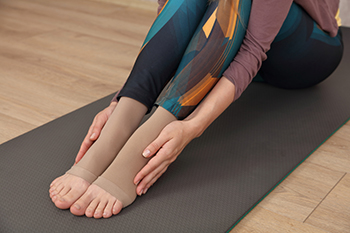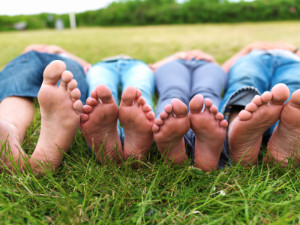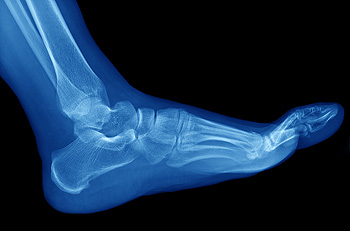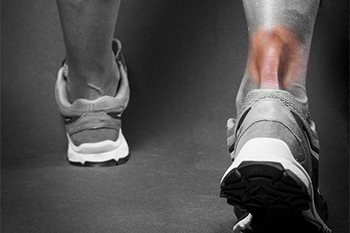May 2023
Poor Circulation of the Feet

Poor blood circulation can cause the feet to feel cold, numb, or tingly. It can also cause dry skin on the feet and brittle toenails. This happens because there is an interference with blood delivery of vital oxygen and nutrients to the feet. Poor circulation can make wounds heal slower and increase the risk of infection. Lifestyle changes may help some patients, and others may have to take medicine to widen blood vessels. Though vitamins and supplements cannot cure circulation problems, they may provide relief from symptoms. If you have signs of poor circulation in your feet, it is strongly suggested that you visit a podiatrist as quickly as possible who can determine what the cause is, and offer advice on treatment.
Poor circulation is a serious condition and needs immediate medical attention. If you have any concerns with poor circulation in your feet contact Dr. Thomas Madden of Advanced Foot Care Center. Our doctor will treat your foot and ankle needs.
Poor Circulation in the Feet
Poor blood circulation in the feet and legs is can be caused by peripheral artery disease (PAD), which is the result of a buildup of plaque in the arteries.
Plaque buildup or atherosclerosis results from excess calcium and cholesterol in the bloodstream. This can restrict the amount of blood which can flow through the arteries. Poor blood circulation in the feet and legs are sometimes caused by inflammation in the blood vessels, known as vasculitis.
Causes
Lack of oxygen and oxygen from poor blood circulation restricts muscle growth and development. It can also cause:
- Muscle pain, stiffness, or weakness
- Numbness or cramping in the legs
- Skin discoloration
- Slower nail & hair growth
- Erectile dysfunction
Those who have diabetes or smoke are at greatest risk for poor circulation, as are those who are over 50. If you have poor circulation in the feet and legs it may be caused by PAD and is important to make changes to your lifestyle in order to reduce risk of getting a heart attack or stroke. Exercise and maintaining a healthy lifestyle will dramatically improve conditions.
As always, see a podiatrist as he or she will assist in finding a regimen that suits you. A podiatrist can also prescribe you any needed medication.
If you have any questions please feel free to contact our office located in Killeen, TX . We offer the newest diagnostic and treatment technologies for all your foot and ankle needs.
What Can Be Done About Bunions

A bunion is medically referred to as a hallux valgus. It is a deformity of the metatarsophalangeal joint at the base of the big toe. This type of malformation can develop when the first metatarsal bone in the foot turns out, and the big toe shifts toward the other toes. Eventually, the fluid-filled sac that surrounds and cushions the joint may become inflamed, and the entire joint can become stiff and painful. A bunion can interfere with walking or exercising. Additionally, it can be difficult to find shoes that accommodate this protrusion, and if shoes do not fit properly, extra pressure may be put on this misaligned joint. Bunions are more common in women. Perhaps this is because women are more apt to wear narrow, pointed, or high-heeled shoes. Bunions can also be genetic, or may develop from an underlying illness, such as arthritis, or an abnormal foot structure. Some foot problems, such as high arches or flat feet, can predispose one to getting a bunion. A podiatrist can determine the severity of a bunion and recommend the appropriate treatment for it. If you have a bunion, it is suggested that you make an appointment with this type of doctor for an examination and relief options.
If you are suffering from bunion pain, contact Dr. Thomas Madden of Advanced Foot Care Center. Our doctor can provide the care you need to keep you pain-free and on your feet.
What Is a Bunion?
Bunions are painful bony bumps that usually develop on the inside of the foot at the joint of the big toe. As the deformity increases over time, it may become painful to walk and wear shoes. Women are more likely to exacerbate existing bunions since they often wear tight, narrow shoes that shift their toes together. Bunion pain can be relieved by wearing wider shoes with enough room for the toes.
Causes
- Genetics – some people inherit feet that are more prone to bunion development
- Inflammatory Conditions - rheumatoid arthritis and polio may cause bunion development
Symptoms
- Redness and inflammation
- Pain and tenderness
- Callus or corns on the bump
- Restricted motion in the big toe
In order to diagnose your bunion, your podiatrist may ask about your medical history, symptoms, and general health. Your doctor might also order an x-ray to take a closer look at your feet. Nonsurgical treatment options include orthotics, padding, icing, changes in footwear, and medication. If nonsurgical treatments don’t alleviate your bunion pain, surgery may be necessary.
If you have any questions, please feel free to contact our office located in Killeen, TX . We offer the newest diagnostic and treatment technologies for all your foot care needs.
Feet Growth in Children

Many new parents often ask podiatrists how frequently they should be buying their children new shoes. The answer to this question is closely related to the speed at which a child’s feet are supposed to grow. It is important to note that the first three years of a baby’s life witness the fastest growth of their feet. Due to this quick rate of growth, a parent might purchase a new, slightly larger pair of shoes for their baby every three to four weeks. However, the frequency with which new shoes are purchased will slowly decrease as the child ages. Importantly, once a child reaches the age of fourteen, it is generally thought that their feet will more or less stop growing. At this point, a parent need not continue purchasing larger shoes. If you are a parent and seek advice on taking care of your children’s feet, it is suggested that you contact a podiatrist for an appointment.
Making sure that your children maintain good foot health is very important as they grow. If you have any questions, contact Dr. Thomas Madden of Advanced Foot Care Center. Our doctor can provide the care you need to keep you pain-free and on your feet.
Keeping Children's Feet Healthy
Having healthy feet during childhood can help prevent medical problems later in life, namely in the back and legs. As children grow, their feet require different types of care. Here are some things to consider...
Although babies do not walk yet, it is still very important to take care of their feet.
Avoid putting tight shoes or socks on his or her feet.
Allow the baby to stretch and kick his or her feet to feel comfortable.
As a toddler, kids are now on the move and begin to develop differently. At this age, toddlers are getting a feel for walking, so don’t be alarmed if your toddler is unsteady or ‘walks funny’.
As your child gets older, it is important to teach them how to take care of their feet.
Show them proper hygiene to prevent infections such as fungus.
Be watchful for any pain or injury.
Have all injuries checked by a doctor as soon as possible.
Comfortable, protective shoes should always be worn, especially at play.
If you have any questions please feel free to contact our office located in Killeen, TX . We offer the newest diagnostic and treatment technologies for all your foot and ankle needs.
Stress Fractures Happen Gradually

A stress fracture is a broken bone. There are several types of fractured bones, and stress or hairline fractures generally happen gradually. The feet are a common place for stress fractures which typically result from overuse. People who enjoy running may experience stress fractures, but they may be prevented when proper warming up and cooling down are practiced. Research has shown that people who frequently wear high heels or other shoes that do not fit correctly may develop stress fractures from the consistent pressure the feet endure. Additionally, this type of fracture may happen from increasing running speed and distance too soon, as the feet need time to adapt. Patients who perform weight training on opposite days may notice their bodies becoming stronger, and running can become easier. If you develop a stress fracture, it is strongly suggested that you speak with a podiatrist who can provide the best treatment for you.
Activities where too much pressure is put on the feet can cause stress fractures. To learn more, contact Dr. Thomas Madden from Advanced Foot Care Center. Our doctor can provide the care you need to keep your pain free and on your feet.
Dealing with Stress Fractures of the Foot and Ankle
Stress fractures occur in the foot and ankle when muscles in these areas weaken from too much or too little use. The feet and ankles then lose support when walking or running from the impact of the ground. Since there is no protection, the bones receive the full impact of each step. Stress on the feet can cause cracks to form in the bones, thus creating stress fractures.
What Are Stress Fractures?
Stress fractures occur frequently in individuals whose daily activities cause great impact on the feet and ankles. Stress factors are most common among:
- Runners
- People affected with Osteoporosis
- Tennis or basketball players
- Gymnasts
- High impact workouts
Symptoms
Pain from the fractures occur in the area of the fractures and can be constant or intermittent. It will often cause sharp or dull pain with swelling and tenderness. Engaging in any kind of activity which involves high impact will aggravate pain.
If you have any questions please feel free to contact our office located in Killeen, TX . We offer the newest diagnostic and treatment technologies for all your foot and ankle needs.
Gout Pain Can Be Managed
Facts About Achilles Tendon Ruptures

Pain in the back of the heel often indicates a problem with the Achilles tendon, and there are numerous ways this can occur. The top three risk factors for tearing or rupturing this strong tendon are training too hard, pushing off the ground with great force, or a rapid change of direction. While these factors are mainly related to athletic activities, many others can contribute to an Achilles tendon injury. Among them are wearing high heels, having tight or weakened calf muscles, and overpronating when you walk or run. Having high arches, aging, and some types of arthritis can also put you at risk. Ankle instability, taking certain antibiotic medication, and changing the type of surface for an activity are additional risk factors. If you are experiencing any form of ankle pain in the back of the heel that inhibits the completion of your daily activities, it is suggested that you make an appointment with a podiatrist who can discover the cause and treat it.
Achilles tendon injuries need immediate attention to avoid future complications. If you have any concerns, contact Dr. Thomas Madden of Advanced Foot Care Center. Our doctor can provide the care you need to keep you pain-free and on your feet.
What Is the Achilles Tendon?
The Achilles tendon is a tendon that connects the lower leg muscles and calf to the heel of the foot. It is the strongest tendon in the human body and is essential for making movement possible. Because this tendon is such an integral part of the body, any injuries to it can create immense difficulties and should immediately be presented to a doctor.
What Are the Symptoms of an Achilles Tendon Injury?
There are various types of injuries that can affect the Achilles tendon. The two most common injuries are Achilles tendinitis and ruptures of the tendon.
Achilles Tendinitis Symptoms
- Inflammation
- Dull to severe pain
- Increased blood flow to the tendon
- Thickening of the tendon
Rupture Symptoms
- Extreme pain and swelling in the foot
- Total immobility
Treatment and Prevention
Achilles tendon injuries are diagnosed by a thorough physical evaluation, which can include an MRI. Treatment involves rest, physical therapy, and in some cases, surgery. However, various preventative measures can be taken to avoid these injuries, such as:
- Thorough stretching of the tendon before and after exercise
- Strengthening exercises like calf raises, squats, leg curls, leg extensions, leg raises, lunges, and leg presses
If you have any questions please feel free to contact our office located in Killeen, TX . We offer the newest diagnostic tools and technology to treat your foot and ankle needs.





